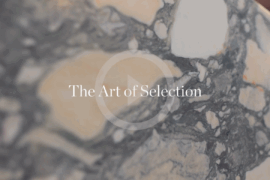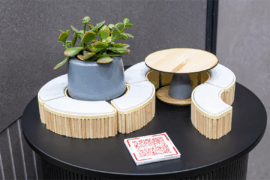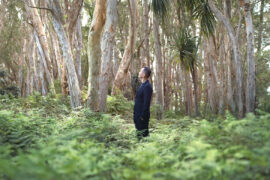For the first time, a full-scale version of Tokujin Yoshioka’s “KOU-AN Glass Teahouse” will be on show for the public to enjoy.

April 6th, 2015
Tokujin Yoshioka is famously known for using reflective and transparent material in his work – think chairs grown from crystals (Spider chair), a table that’s almost invisible (Luminous for Glas Italia), and an entire exhibition dedicated to crystal installations (Crystallize, see our story here).
A work that goes even further back, the Transparent Japanese House from 2002 was more recently the inspiration for a Japanese glass teahouse, which Yoshioka first presented as a small-scale model at Glasstress 2011, at the 54th La Biennale di Vennezia.
The idea behind the teahouse project arises from Yoshioka’s interest in the Japanese view of nature, which is characterised by the way space is perceived, and involves sensing the energies communicated in the environment. He notes that such a sensual appreciation for nature’s intrinsic qualities runs parallel to the rituals found in the Japanese tea ceremony.
As is apt perhaps, given the cultural symbolism of the Japanese teahouse, the KOU-AN project will be exhibited in a monumental location at Seiryu-den, which forms part of the Shoren-in temple in Kyoto, a designated national treasure of Japan.
The teahouse will be built on a platform located 220 metres above ground, with a stunning view over the city of Kyoto.
The exhibition runs from 9 April 2015 – April 2016 (tba) at Shogunzuka Seiryu-den (Shoren-in Temple), 28 Zushiokukacho-cho, Yamashina-ku, Kyoto-city, Kyoto 607-845.
Tokujin Yoshioka
tokujin.com
INDESIGN is on instagram
Follow @indesignlive
A searchable and comprehensive guide for specifying leading products and their suppliers
Keep up to date with the latest and greatest from our industry BFF's!

CDK Stone’s Natasha Stengos takes us through its Alexandria Selection Centre, where stone choice becomes a sensory experience – from curated spaces, crafted details and a colour-organised selection floor.

From the spark of an idea on the page to the launch of new pieces in a showroom is a journey every aspiring industrial and furnishing designer imagines making.

The undeniable thread connecting Herman Miller and Knoll’s design legacies across the decades now finds its profound physical embodiment at MillerKnoll’s new Design Yard Archives.

London-based design duo Raw Edges have joined forces with Established & Sons and Tongue & Groove to introduce Wall to Wall – a hand-stained, “living collection” that transforms parquet flooring into a canvas of colour, pattern, and possibility.
The internet never sleeps! Here's the stuff you might have missed

In Naturalizing Architecture, Takada moves beyond biomimicry to propose a regenerative vision for the urban environment.

The Parliamentary Friends reconvened at Parliament House, uniting political and professional leaders to champion architecture and design.